 W
WAmblygonite is a fluorophosphate mineral, (Li,Na)AlPO4(F,OH), composed of lithium, sodium, aluminium, phosphate, fluoride and hydroxide. The mineral occurs in pegmatite deposits and is easily mistaken for albite and other feldspars. Its density, cleavage and flame test for lithium are diagnostic. Amblygonite forms a series with montebrasite, the low fluorine endmember. Geologic occurrence is in granite pegmatites, high-temperature tin veins, and greisens. Amblygonite occurs with spodumene, apatite, lepidolite, tourmaline, and other lithium-bearing minerals in pegmatite veins. It contains about 10% lithium, and has been utilized as a source of lithium. The chief commercial sources have historically been the deposits of California and France.
 W
WElbaite, a sodium, lithium, aluminium boro-silicate, with the chemical composition Na(Li1.5Al1.5)Al6Si6O18(BO3)3(OH)4, is a mineral species belonging to the six-member ring cyclosilicate tourmaline group.
 W
WEucryptite is a lithium bearing aluminium silicate mineral with formula LiAlSiO4. It crystallizes in the trigonal - rhombohedral crystal system. It typically occurs as granular to massive in form and may pseudomorphically replace spodumene. It has a brittle to conchoidal fracture and indistinct cleavage. It is transparent to translucent and varies from colorless to white to brown. It has a Mohs hardness of 6.5 and a specific gravity of 2.67. Optically it is uniaxial positive with refractive index values of nω = 1.570 - 1.573 and nε = 1.583 - 1.587.
 W
WFluor-liddicoatite is a rare member of the tourmaline group of minerals, elbaite subgroup, and the theoretical calcium endmember of the elbaite-fluor-liddicoatite series; the pure end-member has not yet been found in nature. Fluor-liddicoatite is indistinguishable from elbaite by X-ray diffraction techniques. It forms a series with elbaite and probably also with olenite. Liddiocoatite is currently a non-approved mineral name, but Aurisicchio et al. (1999) and Breaks et al. (2008) found OH-dominant species. Formulae areFluor-liddicoatite Ca(Li2Al)Al6(BO3)3Si6O18(OH)3F Elbaite Na(Al1.5Li1.5)Al6(BO3)3Si6O18(OH)4 Olenite NaAl9B3Si6O27O3(OH)
 W
WJadarite is a white, earthy monoclinic silicate mineral, whose chemical formula is LiNaSiB3O7(OH) or Na2OLi2O(SiO2)2(B2O3)3H2O.
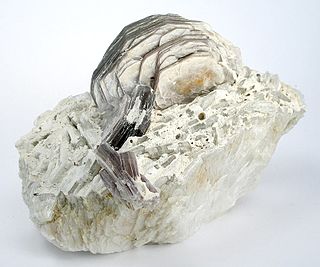 W
WLepidolite is a lilac-gray or rose-colored member of the mica group of minerals with formula K(Li,Al,Rb)2(Al,Si)4O10(F,OH)2. It is the most abundant lithium-bearing mineral and is a secondary source of this metal. It is a phyllosilicate mineral and a member of the polylithionite-trilithionite series. Lepidolite is part of a three-part series consisting of polylithionite, lepidolite, and trilithionite. All three minerals share similar properties and are caused because of varying ratios of lithium and aluminum in their chemical formulas. The Li:Al ratio varies from 2:1 in polylithionite up to 1.5:1.5 in trilithionite.
 W
WLithiophilite is a mineral containing the element lithium. It is lithium manganese(II) phosphate with formula: LiMnPO4. It occurs in pegmatites often associated with triphylite, the iron end member in a solid solution series. The mineral with intermediate composition is known as sicklerite (Li(Mn,Fe)PO4). The name lithiophilite is derived from the Greek philos (φιλός) "friend," as lithiophilite is usually found with lithium.
 W
WNambulite is a lithium bearing manganese silicate mineral with formula: (Li,Na)Mn4Si5O14(OH). It is named after the mineralogist, Matsuo Nambu (born 1917) of Tohoko University, Japan, who is known for his research in manganese minerals. The mineral was first discovered in the Funakozawa Mine of northeastern Japan, a metasedimentary manganese ore.
 W
WNeptunite is a silicate mineral with the formula KNa2Li(Fe2+, Mn2+)2Ti2Si8O24. With increasing manganese it forms a series with mangan-neptunite. Watatsumiite is the variety with vanadium replacing the titanium in the formula.
 W
WPetalite, also known as castorite, is a lithium aluminium phyllosilicate mineral LiAlSi4O10, crystallizing in the monoclinic system. Petalite occurs as colorless, pink, grey, yellow, yellow grey, to white tabular crystals and columnar masses. Occurs in lithium-bearing pegmatites with spodumene, lepidolite, and tourmaline. Petalite is an important ore of lithium, and is converted to spodumene and quartz by heating to ~500 °C and under 3 kbar of pressure in the presence of a dense hydrous alkali borosilicate fluid with a minor carbonate component. Petalite (and secondary spodumen formed from it) is lower in iron than primary spodumen making it a more useful source of lithium in e.g. the production of glass. The colorless varieties are often used as gemstones.
 W
WPezzottaite, marketed under the name raspberyl or raspberry beryl, is a mineral species first recognized by the International Mineralogical Association in September 2003. Pezzottaite is a caesium analogue of beryl, a silicate of caesium, beryllium, lithium and aluminium, with the chemical formula Cs(Be2Li)Al2Si6O18. Named after Italian geologist and mineralogist Federico Pezzotta, pezzottaite was first thought to be either red beryl or a new variety of beryl ("caesium beryl"); unlike actual beryl, however, pezzottaite contains lithium and crystallizes in the trigonal crystal system rather than the hexagonal system.
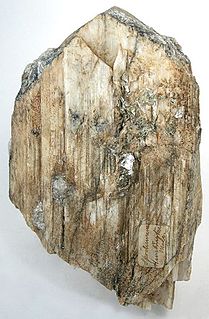 W
WSpodumene is a pyroxene mineral consisting of lithium aluminium inosilicate, LiAl(SiO3)2, and is a source of lithium. It occurs as colorless to yellowish, purplish, or lilac kunzite (see below), yellowish-green or emerald-green hiddenite, prismatic crystals, often of great size. Single crystals of 14.3 m (47 ft) in size are reported from the Black Hills of South Dakota, United States.
 W
WSugilite ( SOO-gi-lyt) is a relatively rare pink to purple cyclosilicate mineral with the complex chemical formula KNa2(Fe, Mn, Al)2Li3Si12O30. Sugilite crystallizes in the hexagonal system with prismatic crystals. The crystals are rarely found and the form is usually massive. It has a Mohs hardness of 5.5 to 6.5 and a specific gravity of 2.75 to 2.80. It is mostly translucent.
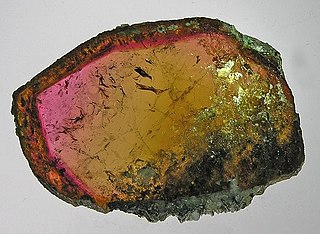 W
WTourmaline is a crystalline boron silicate mineral compounded with elements such as aluminium, iron, magnesium, sodium, lithium, or potassium. Tourmaline is classified as a semi-precious stone. This gemstone can be found in a wide variety of colors.
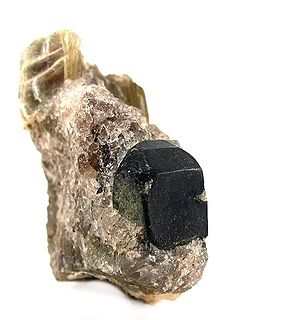 W
WTriphylite is a lithium iron(II) phosphate mineral with the chemical formula LiFePO4. It is a member of the triphylite group and forms a complete solid solution series with the lithium manganese(II) phosphate, lithiophilite. Triphylite crystallizes in the orthorhombic crystal system. It rarely forms prismatic crystals and is more frequently found in hypidiomorphic rock. It is bluish- to greenish-gray in color, but upon alteration becomes brown to black.
 W
WZabuyelite is the natural mineral form of lithium carbonate, with a formula Li2CO3. It was discovered in 1987 at Lake Zabuye, Tibet, after which it is named. It forms colorless vitreous monoclinic crystals.
 W
WThe mineral zektzerite is a member of the tuhualite group and was first found in 1966 by Seattle mineralogist Benjamin Bartlett "Bart" Cannon. It was discovered in the Willow creek basin below Silver Star mountain in miarolitic cavities within the alkaline arfvedsonite granite phase of the Golden Horn batholith, Okanogan County, Washington. It is named for Jack Zektzer, mathematician and mineral collector of Seattle, Washington.
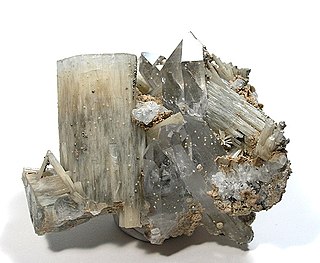 W
WZinnwaldite, KLiFeAl(AlSi3)O10(OH,F)2, potassium lithium iron aluminium silicate hydroxide fluoride is a silicate mineral in the mica group. The IMA status is as a series between siderophyllite (KFe2Al(Al2Si2)O10(F,OH)2) and polylithionite (KLi2AlSi4O10(F,OH)2) and not considered a valid mineral species.
 W
W